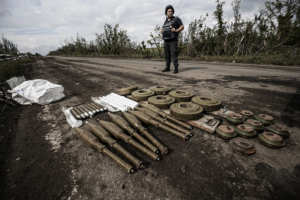We have something in common with ants: Our wars are driven by the same principle, winner take all. Including, in our case, the human body
When it comes to waging war, we have a lot in common with social insects. We both build infrastructure and follow “traffic rules.” We participate in complex teamwork and allocate workers for effective division of labor. The feisty insect soldiers, like humans, can be extremely calculated and brutal: they raid, slay, take slaves and take over territory (warfare is ferocious even on a micro-scale).
The capacity of the Argentine ant to engage in total war has been documented well beyond South America, for instance in southern California. Each week, just under our feet, millions of casualties lie dismembered along borderlines extending for miles near San Diego.
For aviation enthusiasts, there are bee wars that are no less violent and strategic: South American robber bees brutally raid other colonies’ food supplies, while Australia’s stingless bees are all about expansionism and the willingness to pay the ultimate price for conquest. During intense battles, thousands of worker bees perish, and the youngsters from the defeated camp are dragged out of the nest to die.
But there’s one form of brutalization that insects don’t seem to indulge in: rape as a weapon of war. It goes back at least as far as recorded history, and continues to this day.

Sex as weapon
Rape arguably constitutes a different level of atrocity in the “game of war” and when it comes to sheer scale and geographic extent, the Roman armies were among the most “experienced.”
For the Roman war machine, rape was more than just a weapon of terror: it was the right of the victorious. Some even referred to it as an “expression of victory.”
- Genetic study detects unexpected origin of world’s first farmers
- The chicken and the destruction of Beit She’an
- Manhood in Ancient Greece: Battle, Blood and Not Being a ‘Bottom’
- In Ukraine, Russia Is Using Rape as a Weapon of War
“Sometimes rape is used deliberately as an instrument of terror,” points out the renowned political theorist Francis Fukuyama. “The primary purpose of the state is to control violence by creating a legitimate monopoly of force. However, historically this has simply tended to push violence to higher levels of social organization, i.e., inter-state war. Potentially, this makes the overall incidence of violence much greater.”
To return to the mindset at the time, for the historian Livy, who wrote histories of Rome and its people, rape was essentially synonymous with the capture of a city.


As Professor Kathy L. Gaca, an authority on ancient sexual violence puts it, evidence from the 8th century B.C.E indicates that martial rape was a top-down part of the orders given. It was integral to waging warfare, not a “boys will be boys” accompaniment to war. For instance, in the Iliad, Agamemnon’s most senior adviser, Nestor, threatens the Achaean Greek soldiers with death if they try to go home before “properly” conquering Troy, meaning raping Trojan women: “Therefore let none make haste to go till he has first lain with the wife of some Trojan” – Iliad 2.354-359
Arguing that Nestor’s warning wasn’t an example of early literary license – there are accounts of Scipio giving a similar order.
Polybius, one of the most respected military historians, portrays Roman forces practicing conquest rape. He further elaborates that it was a standard condition of female war-captives to be subjected to sexual licentiousness by their conquering forces.

Because war has often been used as an excuse for defending the sexual integrity of the “weaker sex,” consequently, rape represents the defeat of men, literally and figuratively. Livy recounts the story of a Capuan who chooses death rather than having to watch his wife and children being raped.
Tacitus, widely regarded as one of the greatest Roman historians, tells about 40,000 Roman soldiers tearing women and children to pieces upon their arrival at Cremona. He also claims that in the Roman-occupied Batavia, soldiers were seizing boys deemed too young to join the army yet “old enough” for the company of men.
Among the other disturbing accounts in ancient literature, Herodotus, describes the gang rape of Greek women to death by Persian soldiers, and Diodorus Siculus, the author of the Library of History, reveals the ultimate meaning of rape as a weapon of war: Greek women and youths are raped by Carthaginians as a prelude to captivity. Rape did not only serve as an instrument of sexual gratification or a tool for anger relief management; it embodied revenge, subjugation and the enslavement of the defeated.

Soldiers without women
Rape could also serve a more “ambitious” role. When Athenian armed forces ravaged Miletus in the early Iron Age, they killed all the Carian males – and also the mothers of the unmarried young girls. The women became procreative dispensers for the enforcement of Ionian supremacy. Essentially, the Athenian forces raped Miletus into becoming a Greek city.
“In so doing, the Athenians forcibly converted Miletus from the Carian city it used to be to the Greek city. They literally raped it into becoming, for the Athenian men brought no women with them on this colonizing expedition,” writes Kathy Gaca in “The martial rape of girls and women in antiquity and modernity.”
Every first-generation Ionian Greek girl and boy born in Miletus was the daughter/son of a raped Carian girl. Several centuries later, the Persian king Darius ravaged Miletus, at that point his subject city, as punishment for initiating the Ionian Greek rebellion. The sentence was lethal. His forces slaughtered the fighting-age males and enslaved the all the rest.

To put things into context, fighting-age males in antiquity represented about 25 percent of the population, the 75 percent left were the women, children and elders. The women and girls were yet again used as reproductive intermediaries, this time for the Persians. The Athenians were deeply outraged by the Persian conduct, as if they hadn’t slaughtered and raped in Miletus a few centuries before.
Women and children were not the only victims. Sexual assault of adult men remains one of the most closely kept secrets of ancient wars (and remains so today) possibly because even for the ancient writers, it was incompatible with the notion of masculinity: being penetrated/submissive was the most unmanly thing. The acclaimed Roman statesman and orator Cicero was among the few to speak up against war atrocities, urging generals to control their soldiers’ savage tendencies.
Yet, Cicero had no illusion; rape was a war custom and an instrument among generals who used it to reward their troops.

Rape at a time of war is no longer legal, let alone openly encouraged, but it’s still happening.
Fukuyama for one sees the global trend as improving. “Norms regarding behavior in warfare have changed over time and differ between societies. There has been a decline in overall levels of violence over the centuries, and there is also a correlation between the spread of liberal democracy and peace,” he says.
Not all would agree: this trend has been brutally broken by what he himself refers to as “the advent of 20th century total war” – as most recently demonstrated in Ukraine, where widely reported atrocities by the Russians show that rape remains a weapon of war.




